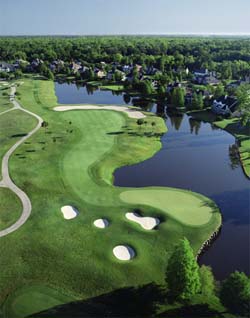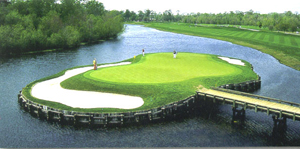Featured Golf News
Golf at English Turn is the Real Deal
More than six years have passed since Hurricane Katrina blasted through New Orleans and tore holes in people's lives that may never be repaired. Many of the area's golf courses were damaged and closed, some to never reopen, but - by the time we pulled into the "Big Easy" earlier in 2011 to check out a handful of its courses and spend a little time looking for some things about New Orleans that I am likely never again to find - most of the area's high-profile tracks were back on line and flourishing.

The par-4 Fourth Hole at
English Turn G&CC
Some, like the celebrated English Turn Golf & Country Club, remade themselves after the big storm and the economic challenges that hit the world soon after. English Turn - with its Jack Nicklaus-designed golf course that hosted New Orleans' PGA Tour stop 16 times (1989-2004 and again in 2006) - adjusted with the times to allow for more outside play.
"We were always very proudly private - but things change," said Sean Rooney, English Turn's head golf professional. "A lot of people who have seen our course on television when we hosted the tour event want to tee it up here, so now they can. We have formed partnerships with some of the local hotels to allow visitors to play the course and we even have special rates for Louisiana residents."
Allowing outside play has not diminished the experience at English Turn, and varying from a strictly private policy has infused some money into the club - which is always a good thing. Members have bought into the strategy, knowing that the economy has taken its toll on everything and just about everyone.
Regardless, English Turn has never wavered about being serious about its golf. The course's highly manicured greens, meandering lakes and magnificent Plantation-style clubhouse make a round here a must-play when in the region.

English Turn Golf & Country Club
Built for the Tour But Playable for Everyone
At English Turn, Nicklaus fashioned gallery berms and spectator mounds all along the course built specifically for the USF&G Classic (now the Zurich Classic). But the "Golden Bear" also knew the track needed to be playable for golfers of all abilities the other 50 weeks of the year and made it so.
With that in mind Nicklaus created 18 unique, championship holes surrounded by an expansive waterway. Each hole is different and there are no holes designed merely to divide residential areas, although a highly desired neighborhood is set outside the Norman Canal that borders and flows through the course. Each English Turn hole challenges you with its own personality.
Water comes into play on every hole. Giant sand and waste bunkers also enter play and numerous grass depressions and mounds line fairways. The greens are notoriously tiered and some are wickedly shallow.
Nicklaus took into consideration the unique drainage issues associated with golf in New Orleans when designing English Turn. Conditions are flawless and consistent, and the par-72, 7,078-yard track - now considered short for a championship course - can be more than a handful when the wind is up (as it always seems to be). English Turn carries a rating of 74.6 and a slope of 140 from the tips.

English Turn's 15th green
The course allows players to ease into a round, as the 539-yard, par-5 second hole (ranked as the No. 18 handicap hole) plays shorter than it's carded and can be attacked as long as the deep bunker that runs the majority of the fairway is avoided.
The meat of the experience at English Turn is its par-4 holes, five of which play at 430 yards or more from the back tees. The front nine sports the 445-yard fifth (with extensive mounding left of the fairway) and the bunker-laden 446-yard seventh, both character-builders requiring the high fade (for right-handers) that Nicklaus preferred to hit.
The back nine has three lengthy two-shotters - the 467-yard 14th, the 430-yard 16th and the daunting 471-yard closer, which was consistently rated one of the PGA Tour's toughest when it came to English Turn. That trio and the 540-yard par-5 15th, which ends on an island green in a pond located to the right of the landing area, make up the stiffest stretch. Leave it to Nicklaus to make sure the holes that would have received the bulk of airtime during a Tour telecast would be the most spectacular.
Players will be amazed at how small some of the greens are at English Turn, none more so than the wide, but maddeningly shallow, putting surface on the 376-yard, par-4 13th. You will need a highly lofted shot from the fairway to keep any ball on the green here.
English Turn, which opened in 1988 and is located just eight miles from New Orleans' Central Business District, makes players execute all the shots to score well.
English Turn is Rich in History
During the spring of 1699 war raged between England and France. The exploration and colonization of the Mississippi River (and plundering of the river's untold riches) were prime concerns for both countries. France had established a small colony along the Mississippi near New Orleans, and England, anxious to control the river, send a warship to invade the French settlement.
Jean-Baptiste Le Moyne de Bienville, lieutenant of that settlement in the Louisiana colony that would become New Orleans, understood the impact of an invasion by the English. He dispatched a small convoy to the British warship anchored below New Orleans. Bienville, approaching the English captain, warned him to depart immediately or face a large-scale military battle. The English turned the warship around and sailed home.
Bienville bluffed the English captain - the French "armada" consisted of two small canoes with five brave Frenchmen. To this day, the grand bend in the Mississippi downriver from Old New Orleans is called "English Turn."
Unlike Bienville's armada, the golf experience at English Turn Golf & Country Club is genuine.
For more information, visit www.englishturn.com.
Steve Habel is one of Cybergolf's world correspondents, contributing news stories, features, equipment and book reviews and personality profiles from his base in Central Texas. He is also works as a contributing editor for Horns Illustrated magazine, a publication focusing on University of Texas sports, covers the Longhorns for CBS Sports, is regional editor for Texas Golfer magazine and files stories for Golf Oklahoma magazine, Texas Links magazines and Golfers Guide. Habel's main blog (www.shotoverthegreen.blogspot.com) features news on golf and the Longhorns, and another (www.checkinginandplayingthrough.blogspot.com)chronicles his many travels, on which he has played more than 350 golf courses since 2009. Habel is a member of the Golf Writers Association of America and the Texas Golf Writers Association.
Story Options
 |
Print this Story |
